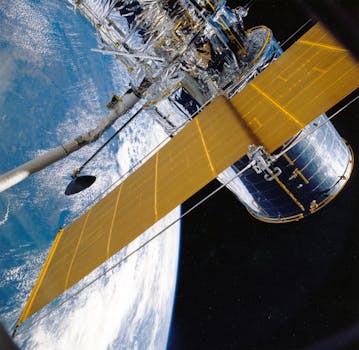
eyond Earth: How Recent Advances in Satellite Tech are Shaping Global Communications
Beyond Earth: How Recent Advances in Satellite Tech are Shaping Global Communications. The advent of satellite technology has been a game-changer for global communications. With the ability to transmit data, voice, and video signals over long distances, satellites have enabled people to stay connected across the globe. Recent advances in satellite tech have further enhanced the capabilities of these space-based systems, enabling faster, more reliable, and more secure communications.
Satellite technology has come a long way since the launch of the first artificial satellite, Sputnik 1, in 1957. Today, there are thousands of satellites orbiting the Earth, providing a range of services including navigation, weather forecasting, and communications. The development of new satellite technologies such as high-throughput satellites (HTS), very high-throughput satellites (VHTS), and low-Earth orbit (LEO) satellites has significantly improved the speed and capacity of satellite communications.
Advances in Satellite Technology
One of the most significant advances in satellite technology is the development of HTS and VHTS. These satellites use advanced technologies such as beam-forming and frequency reuse to increase the amount of data that can be transmitted over a single beam. This has enabled the provision of high-speed broadband services to remote and underserved areas, where traditional fiber-optic connectivity is not available.
Another important development is the launch of LEO satellites. These satellites orbit the Earth at an altitude of around 500-1,000 km, which is much lower than the traditional geostationary orbit (GEO) used by most communications satellites. LEO satellites have several advantages, including lower latency, higher speeds, and reduced signal attenuation. They are also less expensive to launch and operate than GEO satellites, making them an attractive option for new satellite constellations.
Impact on Global Communications
The recent advances in satellite tech are having a significant impact on global communications. With the ability to provide high-speed broadband services to remote and underserved areas, satellites are helping to bridge the digital divide. This is particularly important for communities in developing countries, where access to reliable and affordable internet connectivity is limited.
Satellites are also playing a critical role in disaster response and recovery. During natural disasters such as hurricanes, earthquakes, and tsunamis, traditional communication networks are often disrupted, leaving people without access to vital information and services. Satellites can provide emergency communication services, enabling first responders to coordinate their efforts and providing vital information to affected communities.
Future of Satellite Technology
The future of satellite technology looks bright, with several new developments on the horizon. One of the most exciting is the launch of new satellite constellations, such as OneWeb and Amazon’s Kuiper Systems. These constellations will provide global coverage, enabling people to stay connected anywhere in the world.
Another important development is the integration of satellite technology with other technologies, such as 5G and the Internet of Things (IoT). This will enable the creation of new services and applications, such as smart cities, autonomous vehicles, and remote healthcare.


